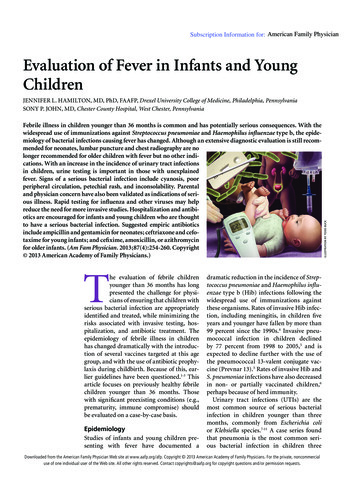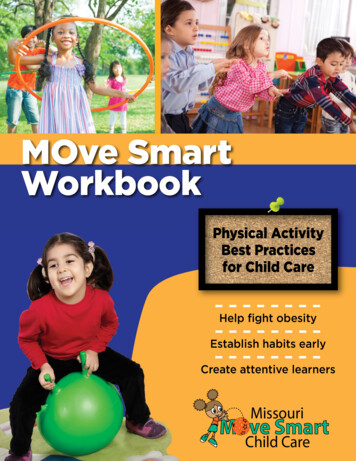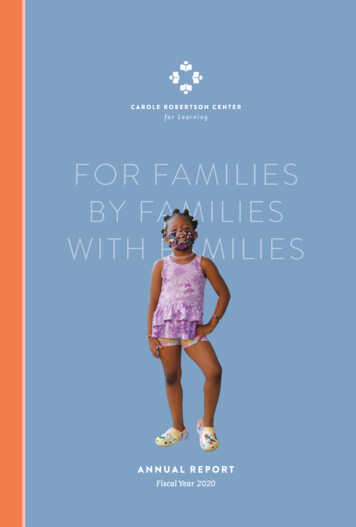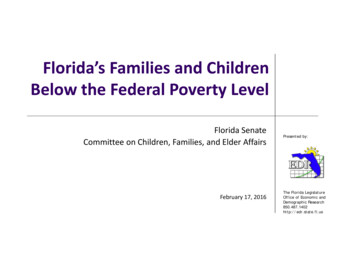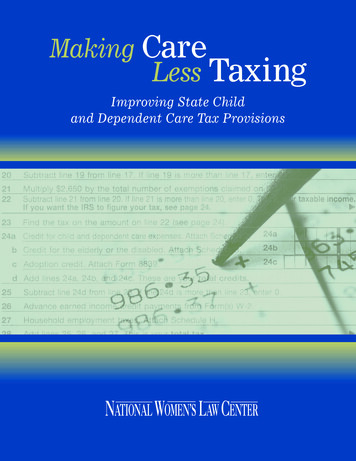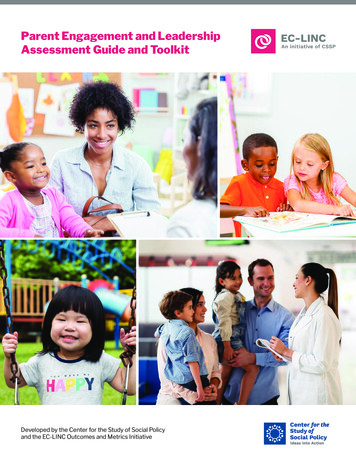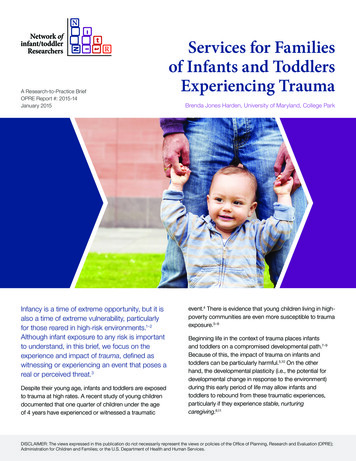
Transcription
A Research-to-Practice BriefOPRE Report #: 2015-14January 2015Infancy is a time of extreme opportunity, but it isalso a time of extreme vulnerability, particularlyfor those reared in high-risk environments.1–2Although infant exposure to any risk is importantto understand, in this brief, we focus on theexperience and impact of trauma, defined aswitnessing or experiencing an event that poses areal or perceived threat.3Despite their young age, infants and toddlers are exposedto trauma at high rates. A recent study of young childrendocumented that one quarter of children under the ageof 4 years have experienced or witnessed a traumaticServices for Familiesof Infants and ToddlersExperiencing TraumaBrenda Jones Harden, University of Maryland, College Parkevent.4 There is evidence that young children living in highpoverty communities are even more susceptible to traumaexposure.5–6Beginning life in the context of trauma places infantsand toddlers on a compromised developmental path.7–9Because of this, the impact of trauma on infants andtoddlers can be particularly harmful.5,10 On the otherhand, the developmental plasticity (i.e., the potential fordevelopmental change in response to the environment)during this early period of life may allow infants andtoddlers to rebound from these traumatic experiences,particularly if they experience stable, nurturingcaregiving.8,11DISCLAIMER: The views expressed in this publication do not necessarily represent the views or policies of the Office of Planning, Research and Evaluation (OPRE);Administration for Children and Families; or the U.S. Department of Health and Human Services.
Services for Families of Infants and Toddlers Experiencing TraumaWe briefly summarize what is known about the impactof trauma on infants and toddlers, and the interventionstrategies that could potentially protect them from theadverse consequences of traumatic experiences. Wefocus on interventions that support parents in providingthe stable and nurturing caregiving that is responsiveto the child’s general developmental needs and thatpromotes children’s sense of safety and security. Suchinterventions may reduce or provide a buffer againstinfants’ traumatic experiences. Finally, we consider howchild care, Early Head Start, home visitation, and childwelfare can become trauma-informed infant/toddlerservice delivery systems.Infants and ToddlersExperiencing TraumaInfants and toddlers can be exposed to a wide rangeof traumatic experiences, including trauma that is acute(i.e., a single event), chronic (i.e., multiple or enduring orrecurring events), and complex (i.e., multiple traumaticevents, often of an invasive, interpersonal nature).3Events that may be traumatic include serious illness (e.g.,hospitalization, painful treatments), accidents (e.g., caraccidents, dog bites, near drownings), separation fromcaregivers (e.g., foster care placement, death of a parent),natural or human-caused disasters (e.g., hurricanes,droughts, famine, war), and poverty-related factors thatcompromise safety and security (e.g., lack of resourcesto fulfill basic needs such as satisfying hunger). Sexualabuse, physical abuse, and other violent events that areinternal and external to the family (e.g., intimate partnerviolence, community violence) are experiences that arealso traumatic for very young children. Further, neglect,which affects a large proportion of maltreated infants(i.e., 62% of maltreated infants have experienced medicaland/or physical neglect),12 can be considered traumaticfor infants given its profound consequences for infantdevelopment. Infants and toddlers in high-risk familiesare often exposed to chronic and complex traumabecause one traumatic experience may be related to andheightened by another (e.g., the co-occurrence of intimatepartner violence and child abuse).About 60% of children 0–17 years old have been exposedto violence in their communities and in their homes withinthe past year.13 Infants and toddlers are far less likely thanolder children to witness community violence, but theyhave similar rates of exposure to family violence as theirolder counterparts.13 Very young children who are raisedin urban, low-income, high-crime areas tend to experiencehigh rates of exposure to violence.6,14 Furthermore, thevery youngest children are more likely to be the directvictims of violence and trauma than older children. Forexample, children under age 3 are more likely to bemaltreated (the definition of which includes abuse andneglect), to experience a recurrence of maltreatment, andto die from maltreatment than older children, particularly ifthey are under 1 year of age.12,15Research suggests that trauma disrupts developmentin significant ways, which may be expressed differently,depending on the child’s phase of development. Infantsand toddlers who experience trauma may be affectedacross many aspects of development, with particularproblems with social-emotional development.4,10,16–18 (SeeTable 1 for a delineation of these outcomes.) The rangeand severity of infant/toddler developmental outcomesrelated to trauma depend on many factors, including theseverity, chronicity, and context of the traumatic eventsthat the child has experienced. More severe trauma andmore chronic trauma lead to more damaging outcomesfor young children.5,92
¡ Smaller brain volume, largerfluid-filled cavities, lessconnective matter, overalldampening of response} Generalized brain impacts:¡ Prefrontal cortex (relatedto executive functioning,impulse control, emotionregulation, consciousthought)¡ Hypothalamus (related tostress reactivity [cortisolproduction])¡ Amygdala (related to emotionregulation, fear, decision making)} Clingy/Fearful behaviors} High levels of emotionality} Aggression} Shaken Baby Syndrome (i.e.,neurological and ocular damageor injury to the eye and nervoussystems as a result of beingshaken)} Vision loss/blindness} Mistrust of adults} Dysregulation of stress systems} Insecure attachment, especiallydisorganized attachment} Post-traumatic play, reducedplay} Toileting problems} Sleep disruption} Failure to meet developmentalmilestones} Failure to thrive} Regression (i.e., return to anearlier level of functioning)} Hypervigilance (i.e., extremealertness and wariness)} Emotional distress} Irritability} Strong startle reactions} Bedwetting} Compromised motor skills} Depression} Death and physical injury} Tantrums} Anxiety} Increased arousal (i.e.,heightened physical andemotional response to theenvironment)} Changes in activity level} Altered cortisol production (i.e.,changes in the release of stresshormones)} Upper respiratory illness, asthma} Re-experiencing events} Changes in sleeping patterns,sleep difficulty, night terrors} Avoiding the location of events} Post-Traumatic Stress Disordersymptoms} Changes in eating patterns,eating difficulties, early obesity} Size reduction and deficits/dysfunction in specific brainregions:¡ Hippocampus (related tomemory, learning, emotionexpression)SOCIAL /EMOTIONAL FUNCTION/INFANT MENTAL HE ALTHPHYSICAL HEALTH/PHYSIOLOGYBR AIN DE VELOPMENTTable 1. Potential Impact of Trauma on Infants and Toddlers10} Later academic problems} Developmental delay} Concentration problems} Verbal/Language deficit} Executive functioning challenges} Cognitive difficultiesCOGNITION AND L ANGUAGEServices for Families of Infants and Toddlers Experiencing Trauma3
Services for Families of Infants and Toddlers Experiencing TraumaTrauma in the immediate environments in which childrenare situated (e.g., children’s homes) is more challenging forthem due to its direct impact on children and the adults onwhom they depend for nurturance, safety, and security. Forexample, witnessing intra-familial violence may be moredamaging than witnessing community violence for infantsand toddlers.20 Adverse outcomes for young childrenexperiencing trauma are worsened by challenges withinthe family environment (e.g., maternal depression14). Finally,as with older children, direct victimization with regardto trauma (e.g., child maltreatment) may be the mostdamaging for infants and toddlers.5,16,20 This is particularlytrue if the perpetrator of the violence or maltreatment isthe child’s primary caregiver because, traditionally, theavailability of stable, nurturing caregiving can potentiallyprotect very young children against the experience oftrauma. Young children may live with two perpetrators oftrauma, or one perpetrator and one parent who fails toprotect the child from victimization. These complexitiesmust be addressed in research and intervention efforts foryoung children who are exposed to trauma.Interventions to Buffer Infants/Toddlers Against TraumaGiven the damage that exposure to trauma can causein the development of infants and toddlers, it is criticalto create policies and strategies to buffer young childrenagainst such adverse experiences. Consistent withthe U.S. Department of Justice’s Defending ChildhoodInitiative,21 we propose to address trauma during infancy/toddlerhood through three potential pathways: (1) directlyreducing interpersonal violence; (2) decreasing theenvironmental risks (e.g., poverty) that place familiesat risk for experiencing trauma; and (3) developing andincreasing the availability of interventions that can bufferyoung children against the consequences of trauma.Interventions addressing these pathways should beincorporated into interventions for the parents of infantsand toddlers exposed to trauma. Such features mayimprove the individual functioning of parents, thusfacilitating their appropriate parenting for their infants andtoddlers who have experienced trauma.Experts in trauma-focused treatment suggest that severalcore components should be included in interventions forolder children and adults in order to reduce the effectsof trauma exposure, including (1) a strong therapeuticrelationship (i.e., an emotional connection betweenthe trauma victim and the interventionist); (2) psychoeducation about normal response to trauma (i.e.,psychologically based training about trauma); (3) parentalsupport, conjoint therapy, or parental training (i.e.,education and therapy for parents); (4) emotion expressionand regulation skills (i.e., a how to appropriately expressand adjust feelings); (5) anxiety management andrelaxation skills (i.e., strategies for managing worry andfeeling relaxed); (6) trauma processing and integration(i.e., how to understand trauma and manage its effect onfunctioning); (7) personal safety training; and (8) resilienceand closure (i.e., overcoming the effects of trauma).3For infants and toddlers, the parent support componentis a key to the effectiveness of trauma interventions.Thus, practitioners must engage parents in supportingtheir infants and toddlers in specific ways that enhancethe child’s feeling of physical and psychological safety.In situations where the parent is the perpetrator of thetrauma, children may have to be removed from theirparents in order to preserve their safety. If traumatizedchildren remain with their parents, interventions needto address parental functioning, as well as improvingparenting behaviors, especially in relation to maltreatmentand other aspects of trauma. Because many maltreating4
Services for Families of Infants and Toddlers Experiencing Traumaparents were victims of child maltreatment themselves,16,22it is also critical to address this intergenerational aspect inthe context of parenting interventions. Practitioners shouldaddress how parents can avoid repeating familial patternsof inappropriate child-rearing strategies.Evidence-based interventions forinfants and toddlers exposed to trauma:Overall, parent-child relationships and interactions mustbe at the core of interventions to address the needsof infants and toddlers exposed to trauma.10,23–24 Thisapproach is at the foundation of two evidence-basedinterventions for trauma-exposed infants and toddlers andtheir families: Attachment and Biobehavioral Catch-upand Child-Parent Psychotherapy.Attachment and Biobehavioral Catch-up (ABC)is an intervention for children ages 0–24 months andtheir parents, which is strongly grounded in theory andresearch on attachment and stress neurobiology (i.e., thestudy of the impact of stress on the body and nervoussystem). ABC is an intervention with standardizedmanuals and methods that was originally designed foryoung children in the child welfare system. Thus, it targetsinfants and toddlers who experience neglect, abuse,intimate partner violence, and placement instability. ABCis delivered to mothers and infants in their homes over thecourse of 10 sessions. Although brief, the ABC programis intensive, addressing four themes: (1) the importance ofparental nurturance; (2) following the child’s lead; (3) theimportance of non-threatening, non-frightening caregivingbehavior; and (4) “overriding” one’s own history and/ornon-nurturing instincts.25 ABC has been implemented witha variety of cultural groups, including African Americanand Latino families.ABC’s effectiveness with infants, toddlers, and theirparents has been documented through randomizedcontrolled trials conducted with foster families and birthfamilies. The findings regarding foster families include (1)ABC infants are more likely to be securely attached totheir foster mothers,26–27 and (2) ABC infants exhibit morenormal patterns of cortisol (stress hormone) production,a key index of stress regulation that has shown atypicalpatterns in traumatized children.25,28 A study of 6- to18-month-old infants living with their birth families whowere receiving child protective services as a result ofalleged or substantiated infant neglect27,29 revealed thatABC mothers showed more sensitivity toward theirinfants. In addition, ABC infants displayed more secureattachment behaviors (e.g., allowing their mothers toconsole them, being able to explore in the presence oftheir mothers) and were less likely to have disorganizedattachment (i.e., these children displayed fewerattachment behaviors that were not typical for youngchildren, such as confusion about whether and how toapproach their mothers).Child-Parent Psychotherapy (CPP) is a dyadicattachment-based treatment (i.e., an interventioncentering on the relationship between adult and child)that targets young children, ages birth to 6, who areexposed to interpersonal violence, in particular, intimatepartner violence and child maltreatment. Families typicallyparticipate for one year in weekly sessions that focus onrestoring safety, promoting emotion regulation, improvingthe child-caregiver relationship, normalizing the traumarelated response, and creating the joint construction of atrauma narrative (i.e., parents and children together devisea way of conveying the story of the traumatic event).24,31The goal of CPP is to facilitate the child’s return to a normaldevelopmental trajectory. This intervention can be deliveredin the clinician’s office or in the family home. Like ABC,CPP has been implemented with diverse populations,including African American and Latino families.CPP’s effectiveness with young children exposed tointerpersonal violence and/or child maltreatment has beenexamined through randomized controlled trials, comparingchildren whose families received CPP to those who didnot. The findings of these studies include (1) preschoolerswho witnessed interpersonal violence and their mothersshowed reductions in Post-Traumatic Stress Disorderand related symptoms following CPP32,51; (2) maltreatedpreschoolers showed better relationship expectationsand improved internal representations of themselvesand their parents following CPP33; (3) maltreated infants5
Services for Families of Infants and Toddlers Experiencing Traumashowed more secure attachments following CPP34;and (4) traumatized toddlers and their mothers showedrelationship improvement, less anxiety and stress, andfewer behavioral problems following CPP.32,35Promising interventions for infantsand toddlers exposed to trauma:Although ABC and CPP are the only rigorously testedinterventions specifically designed for infants and toddlers,there are multiple, promising interventions and strategiesacross a larger age group that may be suitable for infantsand toddlers exposed to trauma. These approachesrange from child-level, to family-level, to communitylevel interventions, all with the ultimate goal of reducingchildren’s exposure to traumatic events and experiencesor buffering them against the adverse outcomes ofexposure to trauma. The following are examples ofpromising interventions that may be suitable for infants,toddlers, and their families. Each are also listed in Table 2.Parent-Child Interaction Therapy (PCIT) is atheoretically and evidence-based intervention for familieswith children from age 2 to 12.36–39 Although PCIT wasdesigned to address childhood behavioral problems,it has been used for families of children who haveexperienced interpersonal complex trauma. Originallydelivered in an office utilizing a one-way mirror and thepractioner providing advice through a two way radiosystem, PCIT can be delivered in a standard clinic/agency or in the family home. PCIT targets improvedquality of the parent-child relationship, reduced childbehavioral problems, enhanced parenting skills, anddecreased parental stress. These goals are achievedthrough educational sessions in which parents learn skillsto enhance their relationships with their children and thenparticipate in live coaching sessions focusing on positivediscipline and responsiveness to children. PCIT has beencarried out with many different populations, includingAfrican American, Latino, and Native American groups.PCIT has a long history of research, including severalrandomized controlled trials. A particularly relevant studywas conducted in which physically abusive parents ofchildren ages 4 to 12 years were randomly assignedto PCIT, PCIT-enhanced, and a standard communitybased parenting group.42 Parents who received PCITwere less likely to have a re-report for physical abusewhen compared to those who did not receive PCIT, anddemonstrated fewer negative parent-child interactions.PCAT is currently undergoing a rigorous evaluationconducted by the University of California, Davis.Parent-Child Attunement Therapy (PCAT) is amodification of PCIT for children ages 12–24 months.Based on the goals and strategies of PCIT, thisintervention is designed to enhance the caregiver-childrelationship, decrease parent and child psychologicalsymptoms, reduce caregiver distress, and increasecaregiver understanding of child development. PCAT canbe delivered in the office or home, and has a duration ofapproximately 8 to 12 weeks.40Another modification of PCIT is the Child-AdultRelationship Enhancement (CARE) intervention, whichtargets children ages 2 to 12 years. The CARE interventioncan be implemented by adults who do not have clinicalbackgrounds, such as child care providers, foster parents,and child welfare workers.41 It is designed to addressinterpersonal acute and complex trauma, includingphysical, sexual, and emotional abuse and neglect.The intervention utilizes the 3 “P” skills, namely praise,paraphrase, and point out behavior, to improve parents’child management skills. There is a trauma educationcomponent to this intervention that allows parents toaddress a child’s problem behaviors in the context of theirawareness of the impact of trauma on children.6
Services for Families of Infants and Toddlers Experiencing TraumaTable 2. Interventions for Families of Infants/Toddlers Experiencing Trauma*NAMEDESCRIPTIONEvidence Based Interventions Targeted to Very Young Children and FamiliesAttachment andBiobehavioral Catch-up(ABC)25-30Theoretically driven and evidence-based brief intervention for children ages 0–2 and their families;10 sessions focused on four target behaviors (i.e., providing nurturance, following the lead, avoidingfrightening behavior, overriding voices from the past); use of video clips throughout and in-the moment commenting to promote positive parental 51Theoretically driven and evidence-based treatment for children ages 0–6 and their families; oneyear of sessions focused on safety, affect regulation, improving the child-caregiver relationship,normalization of trauma-related response, and joint construction of a trauma narrative.Promising Interventions: Designed for Broader Age RangeParent-Child InteractionTherapy (PCIT),36–39,42Parent-Child AttunementTherapy (PCAT)40Theoretically and evidence-based intervention for children ages 2–12 years and their families; didacticand live coaching sessions on parental responsivity and positive discipline; randomized control trialwith physically abusive families – PCIT families are less likely to have re-report of abuse and havefewer negative parent-child interactions. An adaptation of PCIT for 12–24 month olds (PCAT) iscurrently being evaluated.Child-Adult RelationshipEnhancement (CARE)41Modification of PCIT that can be used by adults who do not have clinical backgrounds to addressinterpersonal acute and complex trauma; utilizes cognitive-behavioral strategies to improve parents’child management skills; includes a trauma education component.Trauma Smart Multi-pronged intervention for preschool children in Head Start who are affected by trauma; providestraining for staff, parents, and providers using a trauma framework; delivers trauma-focusedcognitive-behavioral therapy to referred children; offers early childhood mental health consultationto classroom staff regarding the promotion of social-emotional competence and the reduction ofbehavior problems.43Trauma Adapted FamilyConnections (TAFC)44Adaptation of the evidence-based Family Connections intervention that targets families at risk ofneglect to incorporate knowledge and strategies relative to trauma; delivered in the home via onesession per week for 6 months.Child Development –Community Policing(CDCP)45Collaborative model between law enforcement and child mental health professionals that is designedfor children who experience community and/or domestic violence; response is available 24 hours aday, 7 days a week; children and families may receive one to six mental health sessions focused ontrauma; training is available for police and providers.Psychological First Aid(PFA)41,46Community-level response system for individuals immediately following disasters, terrorism, andemergencies; one session is provided to address a variety of post-disaster issues, includingreplacement and connection with social, concrete, and mental health supports.* Although each of these interventions is grounded in research on child trauma, they have varying levels of evidence to support their effectiveness. Some have beentested through randomized controlled trials (e.g., ABC, CPP, PCIT), whereas others are based in the empirical literature but have not been rigorously evaluated.See references for additional information on each intervention’s level of evidence.7
Services for Families of Infants and Toddlers Experiencing TraumaPromising Interventions for Infantsand Toddlers (continued)Trauma Smart is a multi-pronged, early childhoodmental health approach originally designed forintervention with Head Start preschool children (ages 3–5)affected by trauma.43 Head Start staff, parents, and otherproviders receive training on supporting traumatizedchildren using the Attachment, Self-Regulation, andCompetency (ARC) framework.In addition, trauma-focused cognitive-behavioraltherapy is provided for children who demonstrateadverse psychological and behavioral consequencesfrom trauma exposure. Finally, early childhood mentalhealth consultation is provided to Head Start programs,particularly to classroom teachers, with the goals ofpromoting children’s social-emotional competence andreducing their behavioral problems.Trauma-Adapted Family Connections (TAFC) isan adaptation of the evidence-based Family Connectionsintervention.44 This intervention targets families of childrenfrom birth to 18 years of age who are at risk of neglectand typically have histories of complex developmentaltrauma. TAFC is delivered in the home, usually via onesession per week for 6 months. The intervention usesfamily therapy; cognitive-behavioral strategies; and casemanagement to address trauma, family stressors andcrises, and environmental risk factors. Given that TAFCincludes children of all ages in the family who experiencetrauma, it would be important to ensure that practitionersusing this model serve infants and toddlers usingdevelopmentally appropriate strategies.The Child Development – Community PolicingProgram (CDCP) is a collaborative model betweenlaw enforcement and child mental health professionals,which is designed for children of all ages who experiencecommunity and/or domestic violence.45 The interventionis available 24 hours a day, 7 days a week to respondto children and families immediately in the aftermath ofa traumatic event. Children and families may receiveone to six mental health sessions. The model has anarray of services for families, including a home visit thataddresses domestic violence, a three-session post-eventmodel to help parents support traumatized children, andcrisis intervention and follow-up clinical and collaborativeinterventions for trauma-exposed children. The programalso conducts training for police officers, training forclinicians, program conferences, a trauma treatmentclinic, and consultation services. As with the previousintervention, traumatized infants and toddlers may need adifferent set of services than older children.Psychological First Aid (PFA) is a community-levelresponse system for individuals immediately followingdisasters, terrorism, and other emergencies.41,46 Thus,PFA would be available to parents of children of all ages.Typically, one session is provided to trauma-exposedindividuals, which uses information gathering and casemanagement to address a variety of post-disasterissues, such as displacement, safety and comfort,stabilization, and connection with social and servicesupports. Importantly, PFA workers use supportive andtherapeutic strategies to support a family’s sense ofpsychological safety and stability, and connect them withmental health services if needed. The second version ofthe PFA field manual contains a special section on tipsfor parents of infants and toddlers who have experienceda traumatic event.8
Services for Families of Infants and Toddlers Experiencing TraumaHow to Create TraumaInformed Service DeliverySystems for Infants andToddlersBuilding on the work of the National Child TraumaticStress Network,3 programs such as child care, Early HeadStart, home visiting, and child welfare can collaborateto create a trauma-informed service delivery system forinfants and toddlers. Text Box 1 provides a definition fortrauma informed service systems.To meet the objectives outlined in Text Box 1, programsserving infants and toddlers must prioritize the followingstrategies and activities, which are aimed at reducing childtrauma exposure and buffering them against the impact oftrauma. Plans should include details for addressing eachof these areas and for standard, universal follow-through.Screening and Assessment. As part of enrollmentand ongoing assessment strategies, programs shouldscreen families for parent and child experience of trauma.Because young children and families experiencing traumahave unique service needs, it is important to utilize toolsthat address trauma specifically. Clinical and researchexperts on trauma in young children argue for a parentchild relationship approach for assessing infants andtoddlers experiencing trauma.56The screening measures regarding trauma exposureshould include questions that are appropriate for infantsand toddlers, such as separations from caregivers, infantcrying, and physical shaking of the babies. For example,Family Partnership Agreements established with EarlyHead Start families could incorporate questions relatedto child and parent trauma exposure. With the recentchild well-being mandate for child welfare entities,48 it isimportant to gather information about young children’sand parents’ traumatic experiences and deliver servicesthat address the consequences of these for bothchildren’s and parents’ outcomes. Furthermore, given thattrauma exposure can substantially derail young children’sdevelopment, the ongoing developmental assessmentTEXT BOX 1Trauma Informed SystemsTrauma-informed systems instill, into theirorganizational cultures, policies, and practices,knowledge about the impact of traumatic stresson children, parents, caregivers, and serviceproviders.47 A trauma-informed infant and toddlerservice delivery system would aim to achieve thefollowing objectives: (1) maximize physical andpsychological safety for children and families; (2)identify the trauma-related needs of children andfamilies; (3) enhance the well-being and resilienceof children, families, and providers; and (4) partnerwith children, families, agencies, and systems thatinteract with children and families.3of children that occurs in many child-serving programs(e.g., Early Head Start, child care, home visiting) shouldlook carefully for the potential consequences of trauma.Screening and assessment tools in such programmaticcontexts should focus on the outcomes of trauma specificto infants and toddlers (see Text Box 1) and specific topossible inter-generational trauma.Trauma history screening. Although there are multiplemeasures that examine trauma exposure in olderchildren,49 tools that specifically address infants andtoddlers are limited. Two parental report measures thatcan be used to obtain information on trauma exposure forvery young children, which can be used by practitionersand paraprofessionals, are the Child Trust Events Survey(CTES)50–51 and the Trauma Events Screening Inventory(TESI).52–53 CTES is a screening instrument that is used w
also traumatic for very young children. Further, neglect, which affects a large proportion of maltreated infants (i.e., 62% of maltreated infants have experienced medical and/or physical neglect), 12 can be considered traumatic for infants given its profound consequences for infant development. Infants and toddlers in high-risk families




